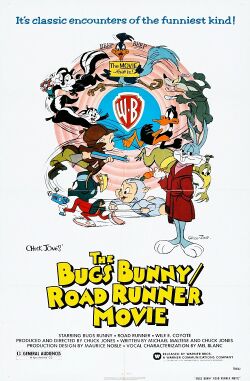The Bugs Bunny/Road Runner Movie
| The Bugs Bunny/Road Runner Movie | |
|---|---|
 Theatrical poster by Chuck Jones | |
| Production company | Chuck Jones Enterprises Warner Bros. Cartoons |
| Distributor | Warner Bros. |
| Release date | September 14, 1979 |
| Run time | 97 minutes |
| Starring | Mel Blanc Stan Freberg Paul Julian Arthur Q. Brian Nicolai Shutorev |
| Producer(s) | Chuck Jones |
| Music composition | Dean Elliot Milt Franklyn Carl W. Staling William Lava John Seedly |
| Screenplay | Chuck Jones Michael Maltese |
| Director(s) | Chuck Jones Phil Monroe (co-director) Classic material: |
| Series navigation | |
| ← Previous | Next → |
| Title card | |

| |
The Bugs Bunny/Road Runner Movie, originally released under the title The Great American Chase Movie, is an American animated package film directed by Chuck Jones, consisting of classic Looney Tunes/Merrie Melodies cartoon shorts and newly animated bridging sequences. It was distributed by Warner Bros. on September 14, 1979, in celebration of Bugs Bunny's 40th anniversary.
Bugs, while giving a tour of his home, talks about some of the famous rivalries, battles, and chases from the Looney Tunes shorts, which serves as introductions to footage from the classic short subjects. The final segment of the film consists of an extended chase sequence between Wile E. Coyote and the Road Runner.
The combination of classic animated footage and new scenes in the film would become the template for all of the theatrically released Looney Tunes films, until Daffy Duck's Quackbusters in 1988.
Summary
The film begins with Bugs Bunny giving a tour his luxourious mansion, which is cantilevered over a carrot-juice waterfall. He gives an explanation on the tounge-in-cheek history of the chase, and how it led to the invention of comedy. After introducing his "several fathers", consisting of notable people involved in Looney Tunes productions, Bugs discusses some of his famous rivalries, battles, and chases, all of which are provided by footage from the classic shorts.
The film's last segment focuses on Wile E. Coyote and his many attempts to catch the Road Runner. At the end of Bugs' tour, they appear as constellations in a chase in the night sky.
Cartoons in order of appearance
- Rabbit Seasoning
- Hare-Way to the Stars
- Duck Dodgers in the 24½th Century
- Robin Hood Daffy
- Duck Amuck
- Bully for Bugs
- Ali Baba Bunny
- Rabbit Fire
- For Scent-imental Reasons
- Long-Haired Hare
- What's Opera, Doc?
- Operation: Rabbit
- Zoom and Bored
- Zip 'n Snort
- Wild About Hurry
- Guided Muscle
- Zipping Along
- Hip Hip-Hurry!
- Hot-Rod and Reel!
- There They Go-Go-Go!
- Whoa, Be-Gone!
- Going! Going! Gosh!
- Stop! Look! And Hasten!
- Scrambled Aches
- Fast and Furry-ous
- Gee Whiz-z-z-z-z-z-z
- Hopalong Casualty
- To Beep or Not to Beep
- Beep Prepared
Memorable quotes
Bugs: I have also been known by other flatterin' names. For instance, I'm called "that wascally wabbit" by a certain E. — Elmer Fudd, who has spent many fruitless and rather frustratin' years chasing me. I have also been know as "That ornery, carrot-eatin' varmint!" by a certain Yosemite Sam, who for some reason hates rabbits. I can't imagine why. What started all this chasin'? When was the very first chase? Well, in order to answer that question, we'll have to swing back in time a little bitty bit.
Bugs: Instead of havin' hundreds of children, like your ordinary "run-of-the-mill" rabbit, I have several fathers. Fathers with odd names like Tex Avery, Friz Freleng, Chuck Jones, and Bob McKimson, the ones who directed me pictures. Fathers like Tedd Pierce, Warren Foster, and Mike Maltese, who wrote most of me biography. And, of course, a father figure named Mel Blanc, who had thousands of voices and was nice enough to give me one of them.
Bugs: Eat ya heart out, Burt Reynolds.
Characters
In order of appearance: | ||||||||||||||||||||||||||||||||||||||||||||||||||||||
| ||||||||||||||||||||||||||||||||||||||||||||||||||||||
Locations
- Earth
- United States
- Bugs' residence
- New York (indirectly mentioned)
- Brooklyn (mentioned)
- New Mexico (indirectly mentioned)
- Albuquerque (mentioned)
- California
- Coachella Valley (mentioned)
- Pismo Beach
- Hollywood
- Animation desk
- Southwest desert
- England
- Nottingham
- Sherwood Forest
- Nottingham
- Spain
- Bullfighting arena
- Middle East
- Ali Baba's treasure cave
- Canada (indirectly mentioned)
- Saskatchewan (mentioned)
- France
- Perfume shop
- Germany
- United States
- Marvin's base
- Planet X
Objects
- "Most Mild Mannered Forest Creature" award
- "Most Easily Frieghtened Shy Rabbit" award
Crew credits
Release
Dates are in order of release:
- United States: September 14, 1979
Behind the scenes
- The film was dedicated to the memory of Chuck Jones' first wife, Dorothy Webster, who died a year before it was released.
- Bugs' mansion is modeled on Frank Lloyd Wright's "Fallingwater" house in Bear Run, Pennsylvania.
- The scene in which Bugs discusses his "several fathers" was written by Chuck Jones as a way to debunk fellow animation director Robert Clampett's claims throughout the 1970s that he alone created Bugs; Clampett's name is notably missing from Bugs' list, as a result of a personal conflict between Jones and Clampett. The documentary movie Bugs Bunny: Superstar featured Bob Clampett, and is another compilation of cartoon shorts, which under-played Bugs' other "several fathers" and is part of the aforementioned conflict.
- It is one of only two compilation films not composed by Robert J. Walsh, the other being Daffy Duck's Quackbusters, which exclusively featured compositions from Carl W. Stalling, Milt Franklyn, and William Lava.
- In some cable TV airings, the second half of the Rabbit Fire segment (following the scene with Bugs and Daffy disguised as each other) was removed.
Errors
Home availability
- In the United States: